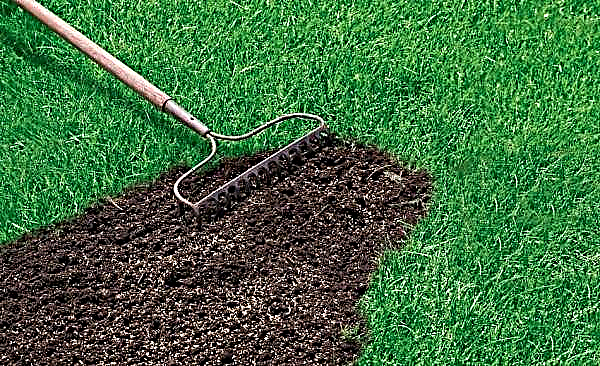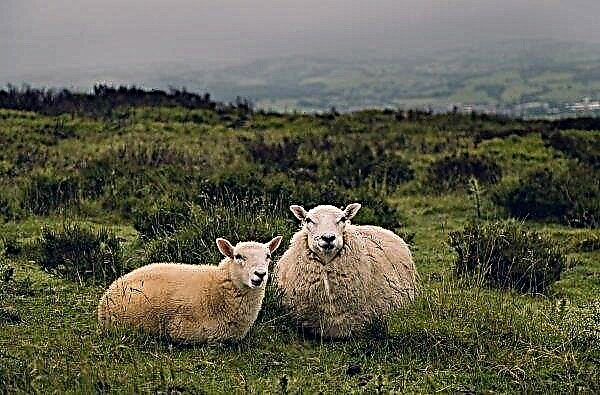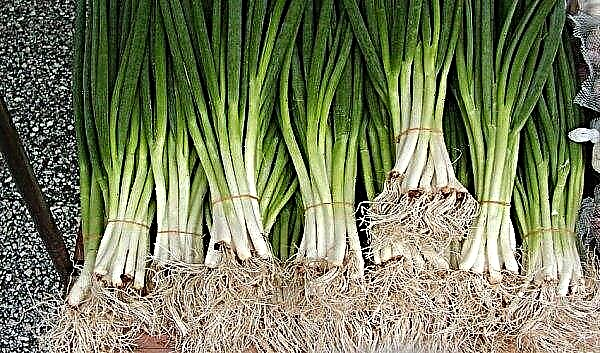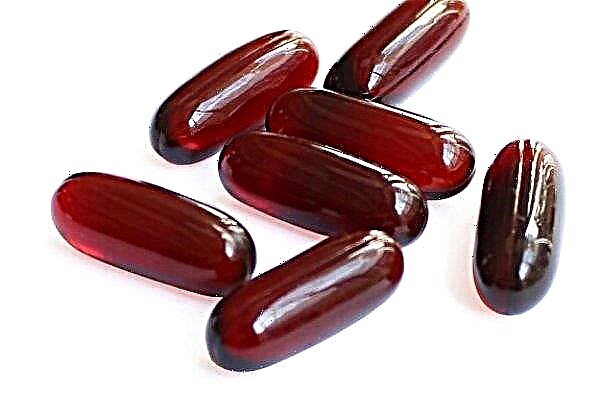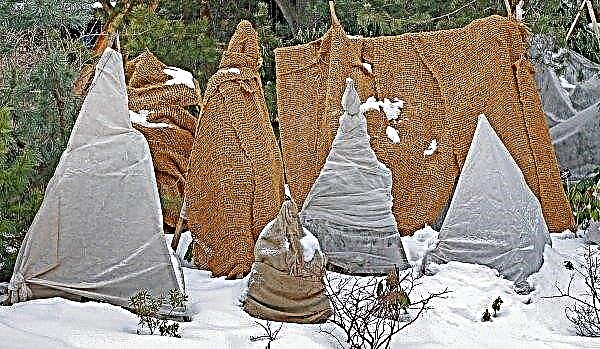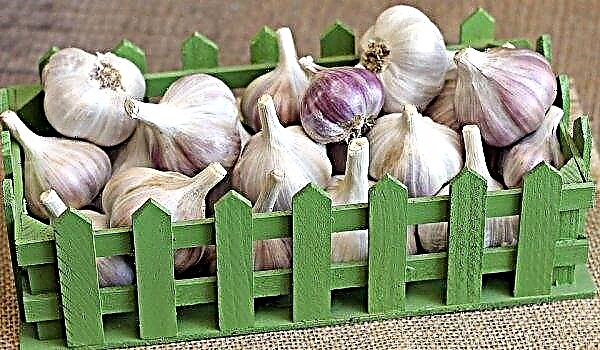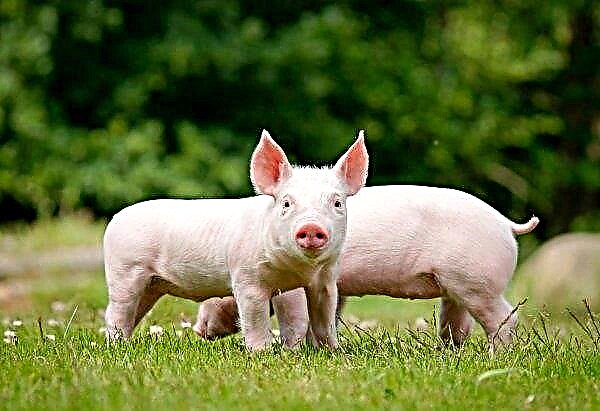European cedar pine (Pinus cembra) has many decorative dwarf forms that are used in the design of gardens, parks and alleys. Although this conifer in its standard form, not derived by humans, is able to decorate any household plot.
Botanical Description
Short description of cedar pine:
- size - height 8–11 m, crown diameter 5–9 m, trunk diameter 1.5 m;
- the shape of the crown is pyramidal or ovoid;
- the family is pine;
- growth rate - refers to slow-growing trees; over the year, shoots grow 18–25 cm high and 8–12 cm wide;
- bark - changes color with age, from pale green to dark brown;
- branches are dense;
- root - deep, slightly branched;
- fruits - ovate cones up to 7–9 cm, purple-brown hue;
- needles - not long, dense, needle-shaped, dense green-blue shade, collected 5 needles each;
- the soil is fertile, moist, the plant can grow in acidic and alkaline soil;
- insolation - the plant loves the sun; needles may fade in the shade;
- relation to humidity - not demanding.

Popular decorative varieties
The species has a variety of varieties. The following is a description of the distinguishing characteristics of the most popular.
Compact Glauca:
- size - height 0.8–1 m, crown diameter 0.5–0.6 m;
- crown shape - asymmetric-conical;
- growth rate - in a year grows by 4–5 cm in height and 2–3 cm in width;
- branches are thick and short, grow unevenly;
- needles - long, dense, dense on the inside of a green-blue hue, light blue outside.

Nana:
- size - height 0.4–0.6 m, crown diameter 25–35 cm;
- crown shape - regular, dense, symmetrical, in the form of an egg or cone;
- the trunk is straight, thin;
- growth rate - for a year it grows by 2-3 cm in height and 1-2 cm in width;
- branches are thin and short, grow evenly and densely;
- needles - long, dense, may vary in length, dense has all shades of green.

Pygmaa (Pygmaea):
- size - height 1–1.3 m, crown diameter 60–70 cm;
- the shape of the crown is wide in the form of a pyramid;
- the trunk is straight, thin;
- growth rate - for a year grows by 3–6 cm in height and 1–2 cm in width;
- branches are thin and short, grow unevenly and densely;
- needles - long, dense, slightly twisted, dense, blue-green.

Landing
Planting European cedar pine consists of several stages:
- Selection and preparation of planting material.
- Preparing the site for planting.
- Planting a plant.
When planting Pinus cembra, it does not need special dressings, for personal reassurance, you can fertilize the plant with standard mineral fertilizers or humus. A pine transplant can be carried out up to 5 years, then its roots will grow, and the plant can be transferred to another place only after careful preparation.Important! An adult tree has a wide and deep root system, so when planting a cedar grove, the distance between seedlings should be from 2 to 4 m.
Seedling preparation
When buying planting material should be in the tank. Noh, if the seedlings are good, you can choose those that are not in pots. Then you should pay attention to the globe around the root system. It should be large and not dry.
Sapling size should be:
- ordinary pine - up to 2.5 m;
- decorative look - up to 40 cm.
Did you know? Pine releases phytoncides, which, according to doctors, have a beneficial effect on people with sick respiratory organs. According to useful indicators, the air in the coniferous forest is equal to the sea.
Seat selection
The planting area should be well-lit and open to air masses. Pinus cembra is not demanding on soil, but sandy soil is preferable. Decorative plant species do not like heavy soil.
Therefore, before planting, it is better to dig the site, and fill the bottom of the pit and seedling with a mixture of fertile soil, sand and clay in a ratio of 1: 2: 1. Also, if the land on the site is very wetland, when planting decorative cedar pines, drainage should be laid - pour gravel-sand mixture at the bottom of the recess with a layer of up to 15 cm.
Technology
Planting a plant can be divided into several steps:
- Dig a hole with a depth of 1 to 1.2 m (depends on the roots of the seedling).
- Drive around the pit with wooden stakes 5–6 pcs.
- Planting material should be placed in the middle of the recess and attached to the stakes.
- Cover the seedling with excavated soil or a mixture of soil.
- Pour the plant with 1 bucket of water and fertilize (humus or nitroammophos, 30-50 g per 1 m²).

Pine care
Cedar pine is not a finicky plant, but for its successful development, do not forget about such things as you care for it:
- watering;
- top dressing;
- pruning
- mulching;
- loosening;
- shelter for the winter.

Watering
In the first year after planting, the pine should be watered several times a month with 1 bucket of water. If the summer season is dry and extremely hot, watering can be increased. An adult plant does not need constant watering, because the coniferous litter around the trunk does not allow drying out. Decorative forms of Pinus cembra, on the contrary, need constant watering and sprinkling. For their successful maturation, it is necessary to spray needles 1 time per week and pour 1 bucket of water once every half a month under the trunk.
Top dressing
After planting pine trees, feeding is rare. Provided that the soil in which the tree grows is poor, it is fed with mineral fertilizers in spring. This should be done 2-3 years after planting a pine.
Loosening and mulching
An adult plant itself creates around itself a layer of mulch from fallen needles, which sometimes should be loosened to let air pass to the roots.Ornamental species need to be mulched several years after planting. Also, the soil around the plant can be loosened to a shallow depth if it is very dense.
Pruning
Sanitary pruning of cedar should be done every spring, before resuming life. It involves the removal of broken or diseased branches during the winter. Forming pruning consists in a small pruning of young shoots. If this is done once a year, the crown of Pinus cembra will be more magnificent.
Winter preparations
If adult European pines do not need shelter for the winter, then young, recently planted trees should be sheltered from severe frosts. The soil around the tree is mulched with sawdust or branches of adult pines, and the top is wrapped with dense material or covered with spruce branches. This procedure is carried out at the end of November, the plant is opened after snow melts, at the end of March or April.
Possible diseases and pests
The plant in question has the following diseases:
- Seryanka. A cancerous disease that engulfs the bark of a tree that dries and falls. The plant exudes much resin. It leads to a slowdown in growth, and sometimes death of pine.
- Necrosis. Captures young branches and roots of a plant. They darken, rot and die.
- Vertun. The dark-brick hue formation on the branches, bends the shoots of a tree.
- Root sponge. Ulcers appear on the root of the pine, from which the trunk of the tree stops growing up and begins to bend.

They fight these ailments with the help of fungicidal drugs and stem injections. Affected areas are trimmed and cleaned.
Important! If the disease affects more than half of the tree, it should be destroyed and removed from the site, so as not to infect healthy plants located nearby.
Malicious insects characteristic of cedar pines:
- Tinder fungus.
- Pine moth.
- Hermes.
- Mite.

These insects suck out useful substances from young shoots of a plant or hit a pine trunk, “eating up” the space in it for their larvae. You need to fight them by spraying the tree with “Karbofos”, “Fufanon”, “Actara” or “Iskra”.
Did you know? Pine tree is considered one of the most "magical". According to the assurances of the esotericists, it relieves nervousness and irritation, nourishes a person with useful energy and does not allow spoiling a person who has a talisman with pieces of this plant.
Breeding methods
The most effective way to propagate European cedar pine is seed. The seeds of Pinus cembra have a thick shell and are in a state of vegetation. They need to be stratified and awakened. For this purpose, the seed at the end of winter is planted in boxes filled with sand, and left in a room with a temperature of +4 ... + 6 ° C. In the spring, after the end of the frost, the seeds are planted in a greenhouse and covered with dense material.
As a rule, about 70% of seeds germinate with this method. If you plant planting material not in a greenhouse, but in open ground, every second seed sprouts.
Use in landscape design
European cedar pine is used in landscape design to create separate sections of the park and design alleys. It is in perfect harmony with both deciduous plants and coniferous relatives.
Best of all, Pinus cembra looks close to:
- mountain ash;
- birches;
- oaks;
- rhododendrons;
- laurel cherries;
- larch trees;
- junipers.

Decorative varieties of this plant are used in the design of alpine hills. Cedar is a good perennial evergreen plant that will delight its owner with rich needles all year round, as well as healthy nuts. And its dwarf forms will add a share of decorativeness to the landscape of any infield.

